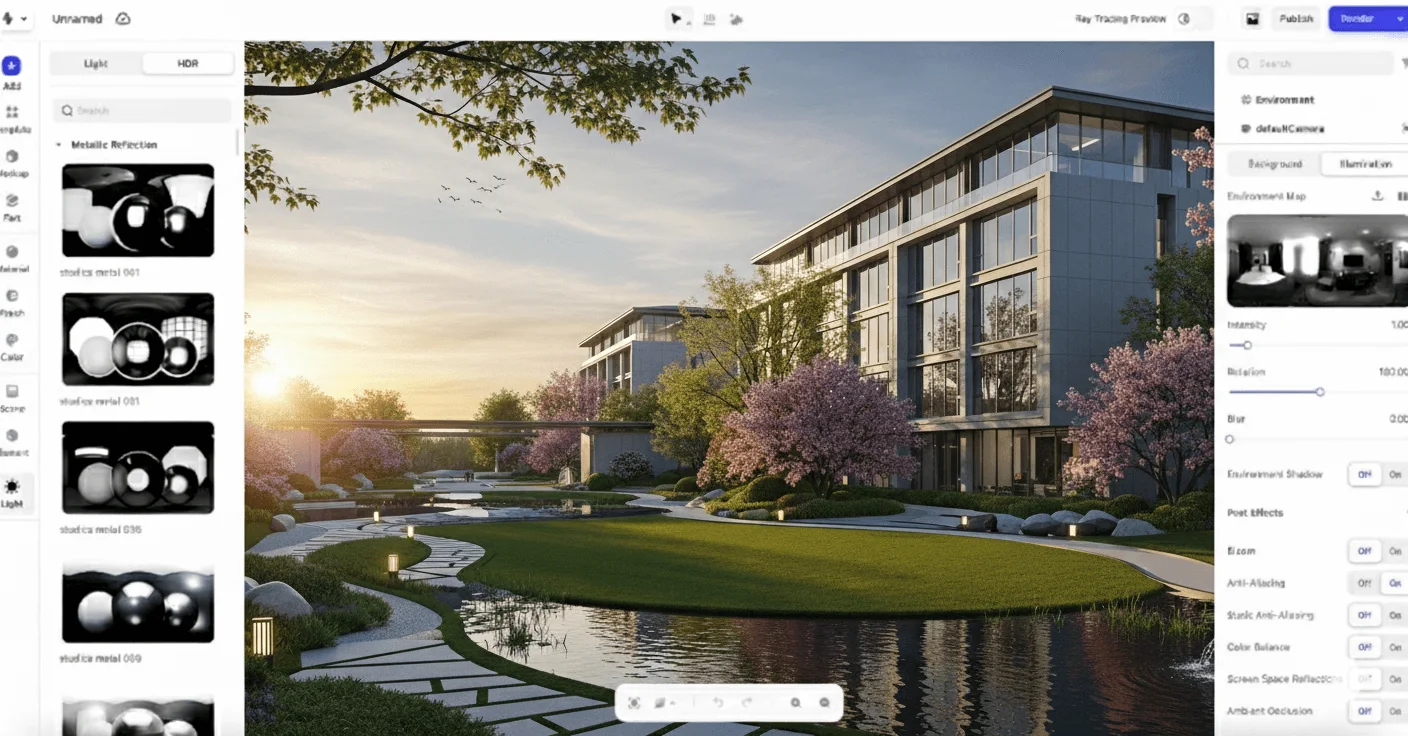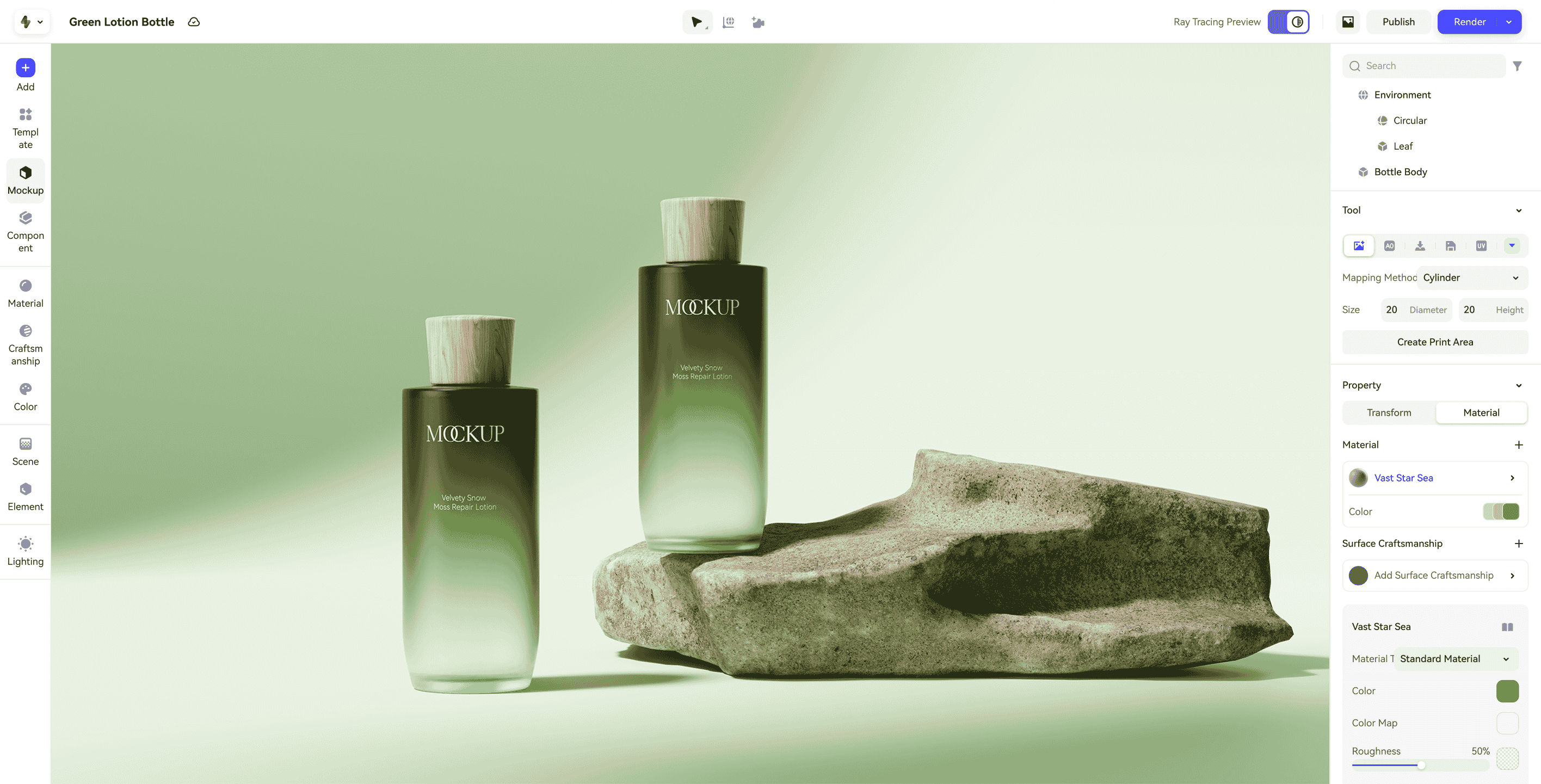Let's be honest. We've all been there. It’s 3 A.M. The deadline isn't just looming; it’s breathing down your neck. And there you are, locked in a staring contest with a progress bar moving so slowly it feels like it's mocking you. The only thing drowning out the jet-engine roar of your PC's fans is the sound of your own sanity fraying at the edges.
This agonizing wait is the shared trauma of every 3D artist. But here’s the brutal truth I’ve learned from years in the trenches: a slow render is more than a technical hiccup. It’s a creativity killer. Every minute spent watching pixels resolve is a minute you're not experimenting with bolder lighting, not testing that wild material idea, not elevating your work from 'good enough' to unforgettable.
Slow rendering is the enemy of great art. So, how do we fight back?
Welcome to your battle plan for achieving faster renders. We’re going to dissect this problem on three distinct levels—from immediate scene optimizations you can implement in the next five minutes, to a fundamental workflow revolution that could make local rendering delays a thing of the past.
Part 1: The Low-Hanging Fruit - Putting Your Scene on a Strict Diet
Before we reinvent the wheel, let's make sure the current one isn't a square. A sluggish 3D scene, much like a bogged-down computer, is often just bloated with unnecessary data. The first and most critical step in understanding how to speed up 3D rendering is to get your scene lean and mean.
Cut the Fat: Taming Your Polygon Count
Think of yourself as a master chef. A great dish isn't defined by the sheer quantity of ingredients, but by the perfect selection of a few key ones. Your scene is no different. The number one culprit for agonizingly slow renders is almost always excessive geometry. I’ve seen a single, ornate screw model, barely visible in the final frame, add crippling minutes to a render.
 Embrace Brutality: Ask the hard question. Does that object truly need that level of detail? If it's a background element, use a low-poly version. Be merciless.
Embrace Brutality: Ask the hard question. Does that object truly need that level of detail? If it's a background element, use a low-poly version. Be merciless. The Power of Instances: If your scene calls for 100 identical chairs, you absolutely should not have 100 unique copies. Use one master chair and 99 "instances." This simple trick tells your renderer to calculate the geometry just once, a savings of processing power that is almost criminally effective.
The Power of Instances: If your scene calls for 100 identical chairs, you absolutely should not have 100 unique copies. Use one master chair and 99 "instances." This simple trick tells your renderer to calculate the geometry just once, a savings of processing power that is almost criminally effective.
Mind Your Textures: The 8K Trap
That jaw-dropping 8K scanned-fabric texture is a work of art. But if you’re slapping it onto a pillow in the far corner of the room, you are forcing your machine to load and process a colossal amount of data for zero discernible benefit.
 Right-Size Your Resolutions: Match the texture resolution to its visibility. For distant objects, a 1K or even 512px map is often indistinguishable from its multi-gigabyte cousin.
Right-Size Your Resolutions: Match the texture resolution to its visibility. For distant objects, a 1K or even 512px map is often indistinguishable from its multi-gigabyte cousin. Smart Formats: Not everything needs to be an uncompressed .tiff or .exr. For basic color information, a well-compressed .jpg is frequently all you need.
Smart Formats: Not everything needs to be an uncompressed .tiff or .exr. For basic color information, a well-compressed .jpg is frequently all you need.
Bend the Rules of Physics (Samples, Bounces, and Caustics)
Here's where we get our hands dirty. At its core, rendering is just a physics simulation of light. The secret is knowing which parts of that simulation you can simplify without anyone noticing. For a deeper look into the mechanics, our full guide on What is 3D Rendering? is a great place to start.
 Samples & The Denoiser's Magic: Renders start noisy and get cleaner with more "samples." In the past, we had to wait for a high sample count. No more. By using a modern Denoiser (more on this miracle tool below), you can use a fraction of the samples and still get a pristine image, slashing render times.
Samples & The Denoiser's Magic: Renders start noisy and get cleaner with more "samples." In the past, we had to wait for a high sample count. No more. By using a modern Denoiser (more on this miracle tool below), you can use a fraction of the samples and still get a pristine image, slashing render times. Light Bounces: Does light in your scene really need to bounce 12 times to look good? Almost never. Dropping this value to a more reasonable 4 or 5 often produces a visually identical result in a fraction of the time.
Light Bounces: Does light in your scene really need to bounce 12 times to look good? Almost never. Dropping this value to a more reasonable 4 or 5 often produces a visually identical result in a fraction of the time. The Caustics Tax: Those dazzling, dancing light patterns refracted through glass or water? They're called caustics, and they are notoriously expensive to calculate. A common misconception is that they're essential for realism. Unless caustics are the star of your shot, turning them off is the single fastest way to get a speed boost.
The Caustics Tax: Those dazzling, dancing light patterns refracted through glass or water? They're called caustics, and they are notoriously expensive to calculate. A common misconception is that they're essential for realism. Unless caustics are the star of your shot, turning them off is the single fastest way to get a speed boost.
Part 2: Shifting Gears - From Brute Force to Brains
With a lean scene, it's time to refine your strategy. This is about making smarter decisions in your workflow that deliver an outsized impact on speed.
Your Secret Weapon: The AI Denoiser
If you take one thing away from this section, let it be this: modern AI Denoising is not a trick; it's a revolution. It intelligently scrubs the noise from a low-sample render, transforming a grainy mess into a finished image in seconds. This means a render that used to take 30 minutes to become clean can now be "done" in 5 minutes, with the AI handling the final 10-second polish. It is, without exaggeration, the biggest leap forward for faster renders in the last decade.
Choose Your Fighter: CPU vs. GPU Rendering
Let’s break it down with an analogy. Your CPU is like a single, brilliant neurosurgeon—incredibly precise and smart, but can only focus on one complex task at a time. Your GPU, on the other hand, is an army of construction workers—less specialized individually, but able to perform thousands of simple tasks in parallel. For the repetitive, brute-force task of calculating light rays, the GPU's army approach is almost always exponentially faster. If your render engine has a GPU option, you should probably be using it.
If You Can't See It, Don't Render It
This is a core principle of visual effects that saves studios countless hours.
 Proxies Are Your Friend: That hyper-detailed city model outside the apartment window? In your working scene, replace it with a simple box. This makes your viewport fluid and responsive. Only swap in the full-detail model at the very last second for the final render.
Proxies Are Your Friend: That hyper-detailed city model outside the apartment window? In your working scene, replace it with a simple box. This makes your viewport fluid and responsive. Only swap in the full-detail model at the very last second for the final render. Activate Camera Culling: Most renderers have a simple checkbox that automatically tells the engine to completely ignore anything outside the camera's view. Make sure it's on. It’s free speed.
Activate Camera Culling: Most renderers have a simple checkbox that automatically tells the engine to completely ignore anything outside the camera's view. Make sure it's on. It’s free speed.
Part 3: The Real Revolution - Escaping Your Local Machine
All the tips above are invaluable. They are the essential toolkit of a skilled 3D artist. But they all operate under one flawed assumption: that the goal is to make your computer struggle less.
What if the problem isn't how hard your computer is working, but that your computer is the one doing the work at all?
The True Bottleneck Is Your Entire Workflow
Let’s zoom out. The render progress bar is just one symptom of a much deeper disease. The traditional 3D process is a sequence of frustrating bottlenecks: the hours lost tweaking complex setups, the productivity destroyed when your machine is locked up and unusable, and—most painfully—the days wasted navigating a clunky client feedback loop. Shaving an hour off a render is a victory, but what if you could shave an entire week off your project timeline?
Realishot: The End of the Local Bottleneck
This is where a modern, cloud-native platform like Realishot doesn't just speed things up; it changes the entire equation. It’s a workflow engineered from the ground up to dismantle the real-world bottlenecks that grind our projects to a halt.
 A beautiful architectural render by Realishot, demonstrating high-quality output without local hardware strain.
A beautiful architectural render by Realishot, demonstrating high-quality output without local hardware strain.
Here’s how it sidesteps the old traps:
 Your Machine is Finally Free: This is the most profound shift. With Realishot, the demanding final rendering happens on a network of powerful cloud servers. While a stunning, ray-traced image is being perfected in the cloud, your local machine remains cool, quiet, and completely responsive. You can prep the next shot, send emails, or simply enjoy the bliss of a silent computer fan. It's not just a speed boost; it's a productivity multiplier.
Your Machine is Finally Free: This is the most profound shift. With Realishot, the demanding final rendering happens on a network of powerful cloud servers. While a stunning, ray-traced image is being perfected in the cloud, your local machine remains cool, quiet, and completely responsive. You can prep the next shot, send emails, or simply enjoy the bliss of a silent computer fan. It's not just a speed boost; it's a productivity multiplier. AI-Powered Look Dev: A huge time-sink is the initial setup—getting the lighting and mood right. Realishot's AI acts like a virtual art director, providing professionally crafted lighting scenarios in seconds. This lets you move past the tedious tweaking and get straight to creative decision-making.
AI-Powered Look Dev: A huge time-sink is the initial setup—getting the lighting and mood right. Realishot's AI acts like a virtual art director, providing professionally crafted lighting scenarios in seconds. This lets you move past the tedious tweaking and get straight to creative decision-making. Project Velocity Through Faster Revisions: Here's the real game-changer. The ultimate speed hack isn't about render times; it's about the feedback loop. Instead of packaging clumsy zip files, you send clients a direct, interactive web link for review. Approvals and changes that used to take days now happen in hours. This browser-based model is defining the future of online 3D rendering software.
Project Velocity Through Faster Revisions: Here's the real game-changer. The ultimate speed hack isn't about render times; it's about the feedback loop. Instead of packaging clumsy zip files, you send clients a direct, interactive web link for review. Approvals and changes that used to take days now happen in hours. This browser-based model is defining the future of online 3D rendering software.
 The simple, clean interface of Realishot invites a faster, more intuitive workflow.
The simple, clean interface of Realishot invites a faster, more intuitive workflow.
At a Glance: Your Pre-Flight Render Checklist
Feeling overwhelmed? Pin this list to your monitor.
 Geometry: Have I eliminated every unnecessary polygon? Am I using instances everywhere I can?
Geometry: Have I eliminated every unnecessary polygon? Am I using instances everywhere I can? Textures: Are any of my textures needlessly oversized for their role in the scene?
Textures: Are any of my textures needlessly oversized for their role in the scene? Denoiser: Is my AI Denoiser enabled? (If not, turn it on now.)
Denoiser: Is my AI Denoiser enabled? (If not, turn it on now.) Light Bounces: Can I lower my bounce count? (The answer is probably yes.)
Light Bounces: Can I lower my bounce count? (The answer is probably yes.) Workflow: Is my own machine still the bottleneck? It might be time to let the cloud do the heavy lifting.
Workflow: Is my own machine still the bottleneck? It might be time to let the cloud do the heavy lifting.
Conclusion: It's Not About a Fast Render, It's About a Fast Idea
We've journeyed from granular scene tweaks to a complete paradigm shift in the rendering process. The core truth is this: the quest for a faster render isn't really about the image. It's about accelerating the journey to a great idea.
A workflow that removes technical friction and vaporizes waiting periods doesn't just free up your processor; it liberates your creativity. It gives you the time and mental space to experiment, to play, to fail, and to stumble upon the one brilliant choice that makes a project sing. While mastering render settings is a craft, the most powerful answer to how to speed up 3D rendering will always be a workflow that gets you to your best ideas, faster.
